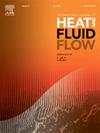Flow mechanism across 180° sharp bend of matrix-cooled serpentine channel
IF 2.6
3区 工程技术
Q2 ENGINEERING, MECHANICAL
International Journal of Heat and Fluid Flow
Pub Date : 2024-12-07
DOI:10.1016/j.ijheatfluidflow.2024.109683
引用次数: 0
Abstract
Vortex merging and evolution mechanisms have been characterized across the 180° sharp bend region of matrix-cooled serpentine channel with the help of stereo Particle Image Velocimetry (PIV) system. Complete evolution of flow phenomenon is captured through measurements in multiple vertical and horizontal planes, and the mechanism responsible for evolution of vortices at a typical Reynolds number (Re) of 6500 has been explored. It was observed that the matrix subchannel typically produces a kind of swirling pattern downstream of the matrix structure, which is similar to the swirling flow occurring in various other application areas. Two co-rotating vortices emanate out of matrix subchannels (observed in secondary plane), which immediately merge into a single vortex at the onset of the bend and propagate further downstream of the bend section, where a pair of side-by-side counter-rotating vortices are observed later. Numerical simulations have also been performed to get the pressure distribution and flow characteristics within oblique/inclined planes along the bend, which are difficult to obtain experimentally through PIV. Results demonstrate that the vortical structures lose their strength during merging and turning, significantly reducing turbulence while passing through the bend. Based on the combination of experimental and numerical observations, a conceptual diagram depicting flow dynamics has been proposed, which provides the overall perspective of vortices evolution and merging across the bend.
求助全文
约1分钟内获得全文
求助全文
来源期刊

International Journal of Heat and Fluid Flow
工程技术-工程:机械
CiteScore
5.00
自引率
7.70%
发文量
131
审稿时长
33 days
期刊介绍:
The International Journal of Heat and Fluid Flow welcomes high-quality original contributions on experimental, computational, and physical aspects of convective heat transfer and fluid dynamics relevant to engineering or the environment, including multiphase and microscale flows.
Papers reporting the application of these disciplines to design and development, with emphasis on new technological fields, are also welcomed. Some of these new fields include microscale electronic and mechanical systems; medical and biological systems; and thermal and flow control in both the internal and external environment.
 求助内容:
求助内容: 应助结果提醒方式:
应助结果提醒方式:


